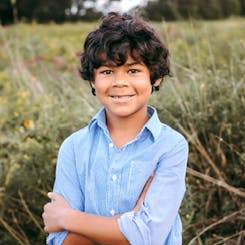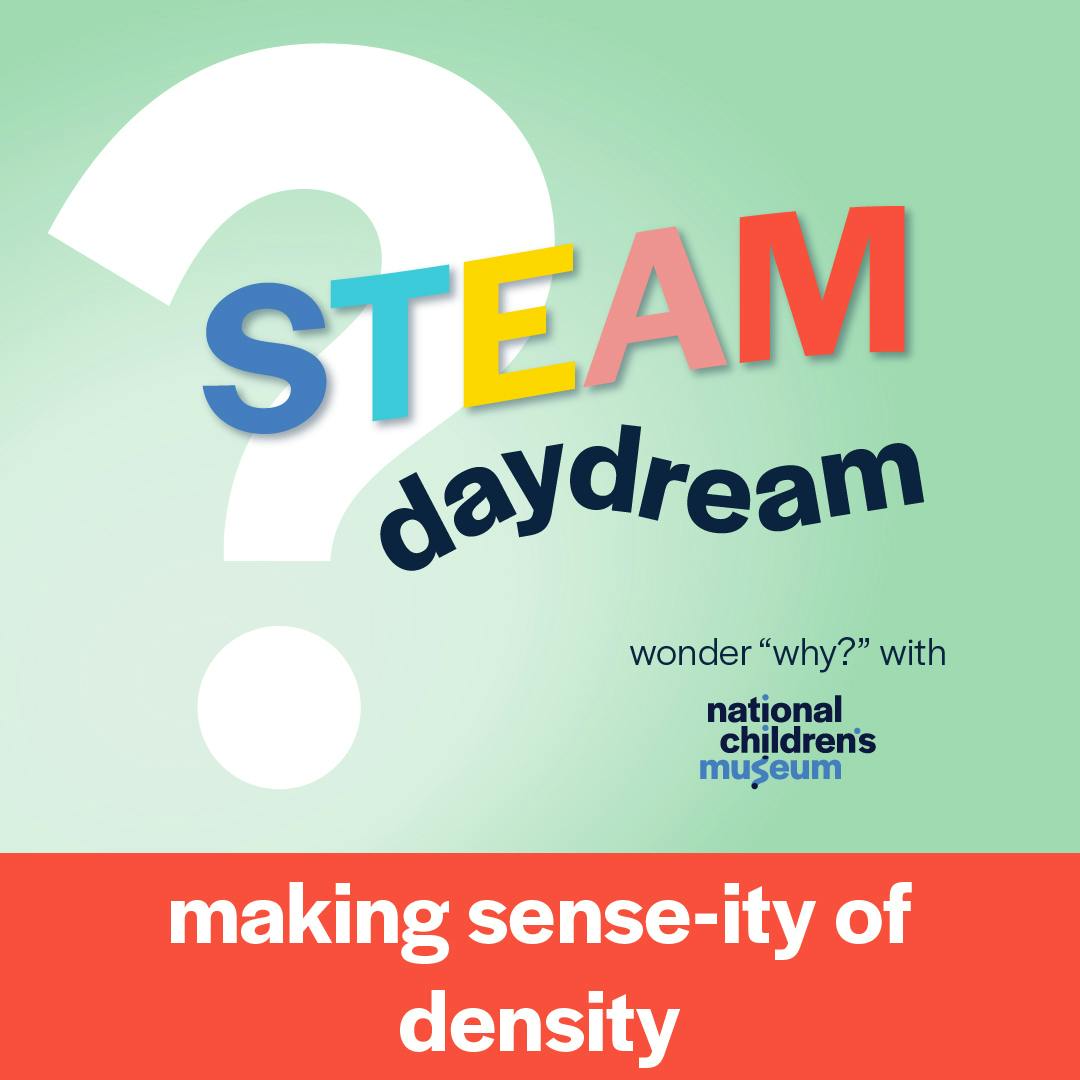making sense-ity of density
Aubrey, Andre, A.J., and 8-year-old Kid Investigator Jack head to the Curiosity Carnival, where all the festivities—treats and games included—are based on a STEAM mystery. This year, the mystery is, “Why do some things float and others don’t?” Will the answer sink in before the carnival ends?
 meet our kid investigator Jack H. (he/him) from Washington, DC 8-years-old favorite school subject: reading |
 meet our expert Madelyn Leembruggen (she/her) PhD Candidate at Harvard University and President and Co-Founder of A World of Women in STEM (WOW STEM) fun fact: ""A black hole is the most dense object in the universe. If you were to compress the entire Earth to be as dense as a black hole, it would be less than one inch in diameter!" |
- matter: anything that has mass and takes up space
- gravity: an invisible force that pulls objects toward each other
- density: the measure of how much mass there is in a particular volume
- weight: the measure of the force of gravity on an object
- mass: the amount of matter an object contains
- volume: the amount of liquid, solid, or gas that can fit inside a 3D shape
- 5-PS1-3 Matter and Its Interactions: Make observations and measurements to identify materials based on their properties.
[MUSIC]
AUBREY: Where’s A.J.? He said he’d meet us in line.
A.J.: Right here!
AUBREY: Oh, hey A.J.! Where’s your STEAM Daydream team shirt? We’re all wearing them, remember?
A.J.: Oh, right... Sorry… My dog ate it?
AUBREY: You’re lucky I brought an extra!
A.J.: Haha—thanks! Anyways. Aubrey, Andre, meet our eight year old kid investigator from Washington, DC, and our fourth team member today, Jack.
ANDRE: Welcome to the team, Jack!
JACK: Thanks! This is actually my first Curiosity Carnival. What’s it all about?
ANDRE: Well, it’s a carnival—but with a twist! There are games and treats just like any other carnival, but at the Curiosity Carnival, they’re all inspired by a STEAM mystery—or curiosity!
A.J.: Each year, a Planning Committee made up of STEAM experts meets to decide on the mystery, which is kept secret until the carnival starts.
AUBREY: People from all around the world come to try to solve it. Whichever team solves the mystery first takes home a grand prize.
JACK: Hm.. How grand of a prize are we talking?
AUBREY: Well, last year, it was a math mystery—something to do with really big numbers. Like the biggest number. Do you remember what it was called, Andre?
ANDRE: Infinitos! Oh, wait, no. That's the name of my favorite pizza place... In-infi- Oh, oh, infinity!
AUBREY: Yes, that’s what it was! Infinity! And the grand prize was an infinite supply of slime.
JACK: Woah, imagine what you could do with an infinite supply of slime!
ANNOUNCER, IN DREAM SEQUENCE: Now, our kid acrobat Jack will dive face first into this pool full of slime!JACK: Sounds sticky.
AUBREY: Oh, it must be time! Look, they’re lowering the drawbridge!
[MUSIC]
A.J.: You’re listening to Season 2 of STEAM Daydream with National Children’s Museum, where we solve the world’s many STEAM mysteries one episode at a time: we’ll observe, we’ll ask questions, we’ll investigate, we’ll research, and then we’ll connect the dots! Listen up, they’re about to announce today’s mystery!
ANNOUNCER: Welcome, everyone, to the Curiosity Carnival! This year’s mystery is why do some things float and others don’t? Be careful crossing the moat, and good luck!
AUBREY: Hmm.. Now that’s a good question. I wonder if the Dreamers at National Children’s Museum have any experience with things that float…
[MUSIC]
FACILITATOR: All right. Can you tell me your name? And how old are you?
CHILD 1: I'm Clark, I'm six.
CHILD 2: My name is Maddie, and I'm seven years old.
CHILD 3: Hi, I'm Leo. I'm nine years old.
CHILD 4: My name is Aubrey. I am eight years old.
FACILITATOR: So today we're talking about things that float and things that don't. I'm going to hold up an object, and then can you describe to me what I'm holding?
CHILD 1: A big Lego piece. It's blue and it's medium size.
CHILD 3: It's pretty hard because if you step on it, it's going to hurt your feet.
FACILITATOR: Okay. Do you think when I put this Lego in this tub of water right here, do you think it's going to float or sink?
CHILD 3: I think it's going to sink because if it was going to float, it would need like- it would have to be really soft.
CHILD 4: I think it's going to float.
FACILITATOR: All right. Ready? Go.
CHILD 4: It is kind of floating. It's at the top.
FACILITATOR: Can you describe to me what this is?
CHILD 2: It's a ball. It has holes in it, and it's blue.
FACILITATOR: Do you think this ball, when I drop it in this tub of water, is going to float? Or do you think it's going to sink to the bottom?
CHILD 2: I think it's gonna float.
CHILD 4: I think it's gonna sink.
CHILD 1: I think it's gonna sink.
FACILITATOR: All right. As you drop it in, tell me what happens.
CHILD 2: It’s floating.
FACILITATOR: Do you know why some things float and others don't?
CHILD 1: Some things float because they're really big and some things sink because they're little.
CHILD 4: Well, it can't be because things are heavy and some things are light because a ship can float, and it's very heavy. But maybe because it's, like, hollow on the inside.
AUBREY: Sounds like we have some leads we may want to follow. According to this map, it looks like there are three different areas: live demonstrations on the float moat that we just crossed, a bizarre buffet featuring food and drinks that float and sink. Oh, and, of course, games!
ANDRE: So what’s our plan?
JACK: Simple—we follow the crowd. This way to the games!
[MUSIC]
AUBREY: Can anyone see what’s happening?
A.J.: No. We have to get closer. Excuse us, excuse us. Sorry, sorry!
ANNOUNCER: Who’s up next? You! in the STEAM Daydream team shirt.
A.J.: Me?
ANNOUNCER: Yes, you! Come on up!
JACK: Go, A.J.!
ANNOUNCER: What’s your name?
A.J.: A.J.?
ANNOUNCER: A.J., welcome to the bobbing station! Go ahead and give the wheel a spin. Whichever fruit or vegetable the wheel lands on is what you’ll be bobbing for in that big tub of water. The goal is to capture a piece as quickly as possible using only your mouth! Our bobbing judge will time you.
A.J.: Okay, here goes nothing!
ANNOUNCER: A.J. will be bobbing for…apples! Ready, A.J.?
JACK: It looks like the apples float on the surface.
ANNOUNCER: 3, 2, 1!
A.J.: Got one!
ANNOUNCER: Way to go A.J., and in record time! Who’s next?
ANDRE: Me! Me!
ANNOUNCER: Okay, give us a big spin! Looks like you’ll be bobbing for…potatoes!
AUBREY: Look, the potatoes sank to the bottom of the tub!
CROWD +ANNOUNCER: Ready?! 3, 2, 1!
ANDRE: I give up!
ANNOUNCER: Someone get him a towel!
A.J.: Better luck next time, Andre.
AUBREY: So why did the potatoes sink while the apples floated?
JACK: Let’s start with what we know.
[MUSIC]
JACK: In my left hand, I’m holding one of the apples, and in my right hand, I have one of the potatoes. Do you notice anything?
AUBREY: Hm, they look like they’re about the same size.
ANDRE: What about weight? Which feels heavier, Jack?
JACK: I think the potato does. Let’s weigh them with this scale.
A.J.: The apple is… 0.3 pounds. And the potato is… 0.6 pounds. So the potato is twice as heavy as the apple.
ANDRE: Okay, that makes sense. The heavier object sinks.
JACK: If that’s true, then this humongous watermelon should definitely sink because it’s much heavier. How much does it weigh, A.J.?
A.J.: 15 pounds!
JACK: Okay, let’s see.
ANDRE: What? The watermelon floats?
JACK: Well, if the size and weight of something doesn’t determine whether it floats, then what does?
A.J.: Maybe the bobbing judge would know. Excuse me!
MADELYN: Um, are you talking to me?
A.J.: Yes, hi! My name’s A.J., and my team and I were wondering if we could ask you a few questions—
AUBREY: Starting with how did you get such an awesome job at the Curiosity Carnival?
MADELYN: My name is Madelyn Leembruggen. I'm a PhD student at Harvard University. They asked me to be a part of the Carnival's Planning Committee this year because I love physics.
ANDRE: Ok, so this year’s mystery must have something to do with physics. What is physics again?
[MUSIC]
MADELYN: Physics is the study of energy. Energy is what causes things to move, light to shine, and atoms or molecules to form into materials. Physics helps us understand why energy does all these things. The laws of physics give objects their physical properties, and those physical properties affect how the objects interact with forces like electricity, magnetism and gravity.
JACK: What do you mean by physical properties?
MADELYN: Physical properties are things like an object's color, roughness, transparency, hardness, magnetism. There's a lot of ways that we can describe an object's properties, and we classify them by observing with our eyes or taking measurements and doing experiments.
AUBREY: A-ha, so maybe a physical property will explain why something floats.
ANDRE: Well, I don’t think an object’s color or hardness has anything to do with whether it floats, and we already ruled out weight with the watermelon. What else could it be?
JACK: Let’s stick the potato in the tub of water again and see if we notice anything.
A.J.: It looks like the water rose a little bit as the potato sank.
MADELYN: When an object is submerged in water, it displaces a bunch of water molecules. The potato forced some water molecules out of its way, and those water molecules had to rearrange. The water didn't disappear when the potato dropped in, it just moved somewhere else, causing the water level to rise. The amount of water that had to move out of the way is exactly equal to the volume of the potato.
ANDRE: Mhm. Volume? What is that again?
MADELYN: Volume is how much 3D space an object takes up. We can find an object's volume by measuring its height, length, and width, and then multiplying those dimensions together. Height, length, and width are all measured in centimeters. So the unit of measurement for volume is cubic centimeters.
JACK: Because the apple and the potato are pretty much the same height, length, and width, they would have about the same volume. So volume alone isn’t our answer, what else could it be?
MADELYN: Have you ever heard of density?
A.J.: No, what’s that?
MADELYN: Density is another type of physical property. It's how we describe how closely all the matter in an object is packed together. You can find an object's density by dividing its mass by its volume. And we measure mass in grams, which means its units are grams per cubic centimeter.
AUBREY: Well, we already know how to calculate an object's volume. We just multiply its height, length and width. But the other part of the density equation is mass. What is that?
MADELYN: Mass is how much matter is in an object. If an object has less mass than another object, that means it just has less stuff in it. I can tell you that the apple has less mass than the potato.
JACK: If the apple has less mass than the potato, and they both have the same volume…That means the apple is less dense than the potato.
MADELYN: That's right. The apple's density is about 0.96 grams per cubic centimeter, while the potato's density is about 1.09 grams per cubic centimeter.
ANNOUNCER: Okay, give us a big spin.
MADELYN LEEMBRUGGEN: Oh, excuse me. Looks like I'm needed at the bobbing station. Good luck with the rest of your investigation.A.J.: Thanks, Madelyn!
ANDRE: We’re so close to solving the mystery, I can feel it!
AUBREY: I think it’s time to put my thinking cap on! Oh, I have an idea!
A.J.: Wow, that thinking cap really does work!
AUBREY: Okay, if density is mass divided by volume, then anything with mass and volume has its own density, right?
ANDRE: I guess so.
AUBREY: And you know what has mass and volume? The water in the tub! We’ve only been paying attention to the apple and the potato, but the water plays an important part in this too.
JACK: That’s a good point!
A.J.: Hey Madelyn! Do you know what the density of water is?
MADELYN: Yeah, it’s 1 gram per cubic centimeter!
AUBREY: Interesting… That’s greater than the apple’s density and less than the potato’s density.
JACK: I think it’s time to connect the dots!
[MUSIC]
ANDRE: Everything made up of matter has physical properties that can be measured or observed without changing around its chemical makeup.
A.J.: Density is an example of a physical property—it’s the measurement of how tightly the molecules of an object or substance are packed together.
JACK: We can calculate the density of an object or substance by dividing its mass by its volume. Mass is the amount of matter an object contains, and volume is the amount of 3D space an object takes up.
AUBREY: The density of liquid water is 1 gram per cubic centimeter, no matter if you’re measuring the density of the water in a cup, or the density of water in a swimming pool.
A.J.: The reason some things float and others don’t comes down to density!
JACK: If an object is less dense than the liquid it’s placed in, it will float on top of the liquid. If it’s more dense than the liquid it’s in, it will sink to the bottom. That’s why some things float and some things don’t!
ANNOUNCER: We have our winning team! Congratulations, STEAM Daydream Team! You solved this year’s Curiosity Carnival mystery!
ANDRE: Alright! What’s the grand prize?
ANNOUNCER: A gigantic unicorn floatie! While it has a large volume, its mass is very small because it’s filled with loosely packed air molecules. Enjoy floating off into the sunset on your very own unicorn!
AUBREY: Wow, a dream come true.
A.J.: Way to go, team! I wonder if I float. Cannonball!
[MUSIC]
A.J.: Well, there you have it! The reason some things float and others don’t comes down to density. Ever wonder why clouds float in the sky and don’t sink to the ground? Part of the answer is that the moist air in the clouds is less dense than the dry air around it. Check out the Cloud Ring Simulator at National Children’s Museum to form your own clouds and send them flying up, up, and away.
[MUSIC]
A.J.: That’s all for today’s episode, Dreamers! Stop by for our next episode, where we'll go back to the drawing board to figure out what makes art, art. Please leave a review to help other curious kids discover our podcasts. Be sure to subscribe wherever you're listening so you don't miss our next adventure. You can find more STEAM programs and resources on our website at www.nationalchildrensmuseum.org. Season 2 of STEAM Daydream with National Children’s Museum is generously sponsored by GEICO. It’s narrated by me, A.J. Calbert, produced by Paige Childs, with sound design and engineering by Maddie Zampanti of Conceptual Podcasting. Take care, Dreamers!

